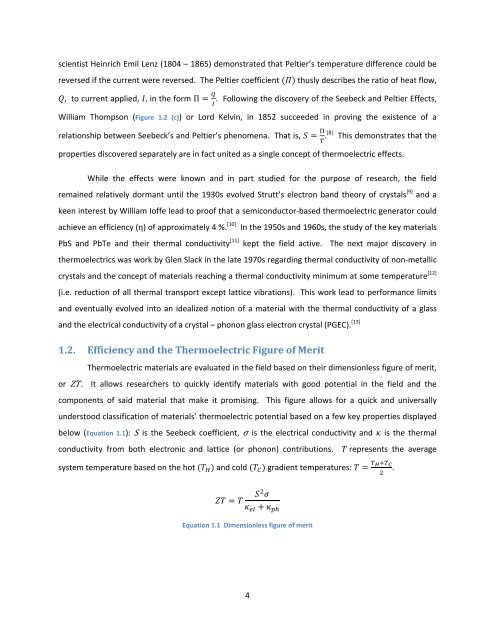Exploration and Optimization of Tellurium‐Based Thermoelectrics
Exploration and Optimization of Tellurium‐Based Thermoelectrics
Exploration and Optimization of Tellurium‐Based Thermoelectrics
You also want an ePaper? Increase the reach of your titles
YUMPU automatically turns print PDFs into web optimized ePapers that Google loves.
scientist Heinrich Emil Lenz (1804 – 1865) demonstrated that Peltier’s temperature difference could be<br />
reversed if the current were reversed. The Peltier coefficient thusly describes the ratio <strong>of</strong> heat flow,<br />
, to current applied, , in the form Π <br />
. Following the discovery <strong>of</strong> the Seebeck <strong>and</strong> Peltier Effects,<br />
<br />
William Thompson (Figure 1.2 (c)) or Lord Kelvin, in 1852 succeeded in proving the existence <strong>of</strong> a<br />
relationship between Seebeck’s <strong>and</strong> Peltier’s phenomena. That is, <br />
.[8] This demonstrates that the<br />
properties discovered separately are in fact united as a single concept <strong>of</strong> thermoelectric effects.<br />
While the effects were known <strong>and</strong> in part studied for the purpose <strong>of</strong> research, the field<br />
remained relatively dormant until the 1930s evolved Strutt’s electron b<strong>and</strong> theory <strong>of</strong> crystals [9] <strong>and</strong> a<br />
keen interest by William I<strong>of</strong>fe lead to pro<strong>of</strong> that a semiconductor‐based thermoelectric generator could<br />
achieve an efficiency (η) <strong>of</strong> approximately 4 %. [10] In the 1950s <strong>and</strong> 1960s, the study <strong>of</strong> the key materials<br />
PbS <strong>and</strong> PbTe <strong>and</strong> their thermal conductivity [11] kept the field active. The next major discovery in<br />
thermoelectrics was work by Glen Slack in the late 1970s regarding thermal conductivity <strong>of</strong> non‐metallic<br />
crystals <strong>and</strong> the concept <strong>of</strong> materials reaching a thermal conductivity minimum at some temperature [12]<br />
(i.e. reduction <strong>of</strong> all thermal transport except lattice vibrations). This work lead to performance limits<br />
<strong>and</strong> eventually evolved into an idealized notion <strong>of</strong> a material with the thermal conductivity <strong>of</strong> a glass<br />
<strong>and</strong> the electrical conductivity <strong>of</strong> a crystal – phonon glass electron crystal (PGEC). [13]<br />
1.2. Efficiency <strong>and</strong> the Thermoelectric Figure <strong>of</strong> Merit<br />
Thermoelectric materials are evaluated in the field based on their dimensionless figure <strong>of</strong> merit,<br />
or ZT. It allows researchers to quickly identify materials with good potential in the field <strong>and</strong> the<br />
components <strong>of</strong> said material that make it promising. This figure allows for a quick <strong>and</strong> universally<br />
understood classification <strong>of</strong> materials’ thermoelectric potential based on a few key properties displayed<br />
below (Equation 1.1): S is the Seebeck coefficient, σ is the electrical conductivity <strong>and</strong> is the thermal<br />
conductivity from both electronic <strong>and</strong> lattice (or phonon) contributions. represents the average<br />
system temperature based on the hot <strong>and</strong> cold gradient temperatures: <br />
.<br />
<br />
<br />
<br />
Equation 1.1 Dimensionless figure <strong>of</strong> merit<br />
4
















